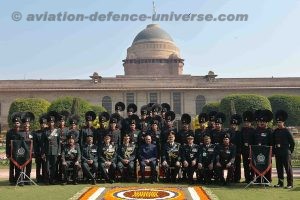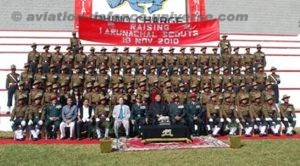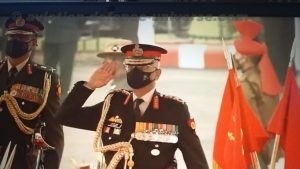
The Naga Regiment is an infantry regiment of the Indian Army. It is among the youngest regiments of the Indian Army – the first battalion was raised in Ranikhet in 1970. The regiment recruits mainly from Nagaland, in northeast India.
- Active: 1970
- Role Type: Line Infantry
- Military Role: Infantry
- Battalion Size: 3 battalions
- Battle cry: Ji Durga Naga
- Regimental Centre: Ranikhet, Uttarakhand
- Regimental Insignia: A pair of crossed Naga spears and a dao( a cutting weapon used by the Nagas), with a shield bearing a mithun(bull) head
- Regimental Motto: “Parakramo Vijayate” (Victory to Valor)
- Regimental Colours: The colours are gold that represents the rising sun, green stands for infantry while red stands for authority.
Soldier Composition:
The regiment’s troops consist of 50% Nagas, while the Gorkahas, Garwalis and Kumaonis consist of the other 50% in equal numbers.
History of the Naga Regiment
The Naga people in 1957 were in a state of insurgency and the youth had taken up arms against the government. A convention of Naga people was organized to bring about peace in the north-east area. The charter of demands put forward had several demands. Prominent among other demands were statehood for Nagaland and a separate unit for the Naga people in the Indian Defence Forces. Statehood was attained in 1963 and subsequently, the Naga Regiment was raised seven years later.
The remarkable fact about 1 Naga raised on 1st November 1970 at Kumaon Regimental Centre, Ranikhet was that 69 Naga rebels and ex-militants joined the Indian Armed forces. Some were even directly appointed as junior commissioned officers.
Unfortunately the training was still in process when the eastern border became a turbulent area requiring immediate deployment of the Naga Regiment. The youngest regiment which was not fully trained and ready for combat found itself on the battle-front in the Indo-Pak war of 1971. However, the innate skills of the Nagas and the Kumaonis, Garhwalis and the Gorkhas kept the honour of the national flag high.
Their inordinate valour led to the raising of another Naga battalion – 2 Naga – on 11 February, 1985 at Haldwani.
Interesting Fact about The Soldiers:
The Naga Regiment is also known as Head Hunters due to their martial history and tradition of cutting off enemy heads and keeping them as war trophies.
The Regimental Battalions
As of now there are 3 Units:
Some of the major operations conducted by this regiment include:
Operation Romeo
It was in Keran sector of Kupwara district, Jammu and Kashmir that 2 Naga participated in one of the landmark operations – Operation Romeo. The goal of this operation was to dominate 24 km of the Line of Control ( LoC), which was wrongly occupied by Pakistan. This entire operation was carried out with amazing results with zero casualties on the Indian side. The young regiment was a trend-setter in this first proactive operation.
India-Pakistani War of 1971
As mentioned earlier 1 Naga proved itself in East Pakistan. It was awarded one Vir Chakra and three Sena Medals.
UN Mission
2 Naga has been deployed on the UN mission in Sudan and was awarded the UN Force Commander’s Appreciation Card.
Kargil War
With the Pakistan Army and mujahideen fighters occupying strategic heights on the Indian side of the LoC, the 2 Naga was among the first units to be inducted into the theatre of conflict.
The 2 Naga regiment carried out a fierce attack on a Pakistan Army mortar position and ammunition dump on Twin Bump in the Point 4875 complex. The 2 Naga destroyed the Pakistan Army position, special mention to Sepoy Imliakum Ao .
To neutralize the offensive from the enemy mortar position, Imliakum’s Company moved to assault and capture Twin Bump. The young soldier approached the sentry guarding the enemy camp in broad daylight and killed him with his ‘dao’. He continued moving forward and attacked the mortar position. Ultimately the entire group of attackers stationed at the mortar position was defeated by the Nagas. The operation was a complete success with no casualties to the Nagas.
The conspicuous act of bravery of Sepoy Imliakum Ao was awarded Mahavir Chakra, the second-highest wartime gallantry award.
2 Naga also participated in the attack on Tiger Hill, where it attacked from the left side and then went on to the strategic Pt 4875 complex. The soldiers of 2 Raj Rif and the ferocious Naga leader Captain Neikezhakuo Kenguruse started the upward march with his Ghatak platoon. Heavy mortar and machine-gun firing was begun From the top of the mountain by the Pakistanis. He was hit in his abdomen. But the Naga moved forward, undeterred. There came a point,when the steep gradient made it difficult for him to climb further. At -10 degrees Celsius above 15,000 feet, he threw away his boots and started moving barefoot.
The Naga leader reached the top with an RPG rocket launcher, fixed the rope for his soldiers and took on the enemy positions single-handedly. He destroyed seven enemy bunkers with the rocket launcher and got wounded again. The wounded Captain was attacked by two Pakistani soldiers however, he used his commando knife to dispatch them to their death. His soldiers reached the top and ferociously attacked the enemy soldiers with the Regimental war-cry “Raja Ramchandra ki Jai”.
But the courageous Captain was unable to witness his troop’s victory at Black Rock of Drass sector as a volley of bullets ended the life of this dare-devil leader just before their triumph.
Decorations Honours and Awards
The Naga Regiment with its furiousness and natural warriors of indomitable spirit and resoluteness in extreme adversity winning several decorations and awards.
These include:
Units
- 1st Battalion
- 2nd Battalion
- 3rd Battalion
- 164 Infantry Battalion (TA) (Jakhama, Nagaland)
Decorations
- 1 Maha Vir Chakra
- 8 Vir Chakras
- 1 Kirti Chakra (Major David Manlun), posthumous.
- 6 Shaurya Chakras
- 1 Yudh Seva Medal
- 1 Vishist Seva Medal
- 48 Sena Medals
Snippets
When the Naga Regiment took over the post at LOC, the Naga were given the customary welcome by firing at shells at their forward post. The Paki soldiers for two consecutive nights threw hand-grenades and ran back. The Naga soldiers to teach the Paki soldiers a lesson, retaliated by capturing two Paki soldiers. They tied the Pakis to a tree, lit a fire and performed a traditional Naga dance and pretended to be cannibals. This scared the Baluch Regiment on the Pakistani side so much that they were nowhere to be seen near the LOC till the Naga battalion was posted there for the next 3 years.
























































































































